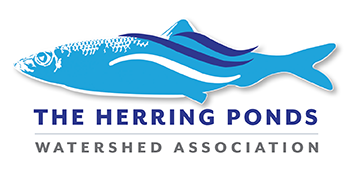Water Quality Report Winter 2023
Don Williams, Water Quality Committee Co-Chair
 Our biggest news (see President Report) is that we have been assured that a Permeable Reactive Barrier (PRB) will be installed early this summer in Carters River between Little Herring Pond (LHP) and Great Herring Pond (GHP). Kim Tower and David Gould of Plymouth’s Department of Marine and Environmental Affairs (DMEA) have set forth an ambitious plan of data-gathering, permitting, and construction to put the PRB in place to remove phosphorus from GHP. We are optimistic that this effort will be successful and that the use of PRBs in streams will be available to other watersheds to prevent harmful cyanobacteria blooms.
Our biggest news (see President Report) is that we have been assured that a Permeable Reactive Barrier (PRB) will be installed early this summer in Carters River between Little Herring Pond (LHP) and Great Herring Pond (GHP). Kim Tower and David Gould of Plymouth’s Department of Marine and Environmental Affairs (DMEA) have set forth an ambitious plan of data-gathering, permitting, and construction to put the PRB in place to remove phosphorus from GHP. We are optimistic that this effort will be successful and that the use of PRBs in streams will be available to other watersheds to prevent harmful cyanobacteria blooms.
In order to obtain baseline total phosphorus data for GHP, Geri Williams, Sara Grady and I took monthly flow rates and total phosphorus samples from April through October at the ingress and egress of GHP. Similar sampling/flow rates will be obtained before and after installation of the PRB next year in order to assess the effectiveness of the PRB in removing phosphorus.
For several years, we have been measuring pollutants (total phosphorus and nitrate) along the course of the watershed from the bog north of LHP to GHP. The measurements start with the old cranberry bog north of LHP and proceed through a north LHP spring, northern, central, and south LHP and end with Carters River and GHP. The largest total phosphorus values are seen in the bog as well as the largest variability (depending on rainfall). Similarly, the spring total phosphorus values are generally low (reflecting underlying aquifer baseline values) but can be much higher following a rainstorm, probably due to overflow from the uphill bog. Surprisingly, north, central, and south LHP can be quite different, while Carters River and GHP are somewhat lower. Thus far, no apparent cause of this variability in phosphorus levels is apparent. GHP total phosphorus has been consistently below eutrophic levels but there is no correlation between these values and the presence or absence of cyanobacteria blooms.
Paul Denoncourt has been a valuable addition to our Board of Directors and to our Water Quality Committee. He suggested that we monitor the total phosphorus in Triangle Pond, a smaller watershed pond, up flow from Carters River for the groundwater and aquifer. The results were surprising; values were consistently low, like the spring (aquifer) results. We can only surmise that the ground water “plume” carrying Ponds of Plymouth septic phosphorus passing from the northwest to southeast is narrow and “misses” Triangle Pond or effectively flushes the phosphorus out of Triangle Pond. We will be suspending this sampling.
Instead, Paul has been looking into getting soil measurements of the bog to try to determine how much phosphorus the bog contains and contributes to the LHP total. If it is determined that the bog makes a significant contribution, we can think about installing a PRB dug in the ground below the bog to trap its phosphorus before it gets into LHP/GHP.
This year, cyanobacteria measurements have remained well below danger limits, peaking in July/August, and decreasing in September/October. These measurements, paid for by Plymouth, roughly correspond to the phycocyanin data obtained using a fluorometer by Geri Williams. No cyanobacteria bloom was observed in GHP this year for the second year in a row.

Comments
Water Quality Report Winter 2023 — No Comments
HTML tags allowed in your comment: <a href="" title=""> <abbr title=""> <acronym title=""> <b> <blockquote cite=""> <cite> <code> <del datetime=""> <em> <i> <q cite=""> <s> <strike> <strong>